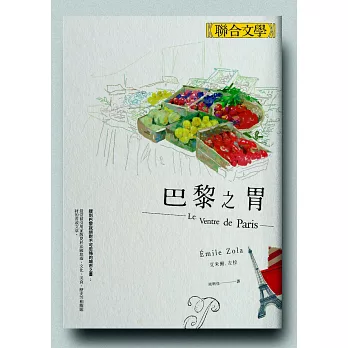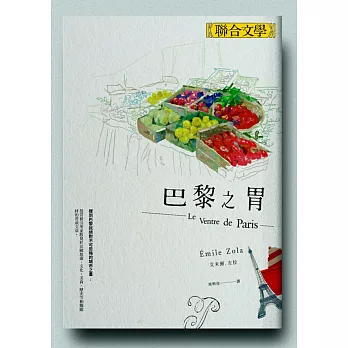鹿島 茂的《巴黎文學散步》

試閱
5
3人評分我要評價
巴黎之胃
Le Ventre de Paris
作者: 埃米爾.左拉
原文作者: Émile François Zola
譯者: 周明佳
出版社:聯合文學
出版日期:2016/01/05
看大圖

!上頁
下頁


試閱
5
3人評分我要評價
巴黎之胃
Le Ventre de Paris
可購買版本(2):電子書優惠價252元
平裝優惠價324元
作者: 埃米爾.左拉 追蹤作者 新功能介紹
原文作者: Émile François Zola
譯者: 周明佳
出版社:聯合文學 訂閱出版社新書快訊 新功能介紹
出版日期:2016/01/05
一場源自巴黎美食的革命,宛如世界的縮影,
人們對於美食的欲望,竟也蔓延成社會各階層的種種不公義?
※法國大文豪左拉最知名的作品之一,繁體中文首譯,
被譽為近代第一本美食小說及經典!
──一道道最具法式誘惑的美食象徵代表,名符其實流動的饗宴
※提到巴黎絕對不可忽略的城市之書
──最常被引用、散見於法國旅遊、文化、美食、歷史等相關題材的書或文章。
故事場景設定十九世紀末,法國首都巴黎市中心最熱鬧、活絡的食品大型貿易市場──巴黎大堂,現今磊阿勒區。在蒙特格尤大街上可見熟食、蔬果、乾貨、生鮮攤遍布的情景,五味雜陳。卻也因為各式新潮店商,成了最多巴黎年輕人聚集流連之處,近似台北的西門町或五分埔。前身是傳統市集的巴黎中央市場,西元一一八三年國王腓力二世擴建巴黎市場,為來自全國各地出售商品商人建立一個遮蔽之處。在十九世紀五○年代,興建了大型的玻璃和鐵構建築體,被稱為巴黎的「肚腹」,也就是巴黎之胃。
故事描述十九世紀中期,在十二月拿破崙政變中,蒙冤流放到魔鬼島的主角佛羅鴻(Florent Quenu)逃脫並返回巴黎去投靠親人。他發現整個城市面目全非已非往昔記憶的樣貌──古遺純真之泉被拆,作為城市重建的宏偉計劃,原址取而代之的是嶄新華美的巴黎大堂(Les Halles)。由於工作之故,他開始在接觸到市場內的各式攤商與貿易商,在龐大繁盛的商業機制下,他漸漸發現整個資產階級社會貿易的體系中,層層剝削和不公義之頻繁,特別是以食物、商品做為華美糖衣掩護,廠商和政府操控、掛勾的互利與蒙蔽,知道得越多,曾蒙冤的他就更難以忍受真相。無可退讓之下,佛羅鴻只得起身抗爭。
此書特別值得紀念之處,在於作者描述文明歷史之過程,佐以左拉對於美食文化印象深刻的描述:各式法式吃食、起司小點甚至最常見的蔬菜生鮮,都在左拉筆下成了一道道最具法式誘惑的象徵代表,名符其實流動的饗宴;巴黎市中心古蹟與文化景點之熟悉等打造出這本從城市歷史文化發展脫胎而成的小說,十九世紀的巴黎風華繁盛之市容與街景等各式文化底蘊,彷彿封存在左拉仔細的描寫和細膩的時代感鋪陳當中。也當下捕捉了以食物為象徵所代表的社會階層、現況、政治衝突和當時文化的各種面向。
作者介紹
作者簡介
埃米爾.左拉Émile François Zola (1840-1902)
出生於巴黎,左拉七歲時,父親患肺炎離開人世,從此孤兒寡母過著饑寒交迫的生活。雖長年貧困,仍堅持寫作,創作詩歌和短篇小說。1862年,左拉進阿歇特出版社當小職員,開始在發行部幹打包裹差使,由於他很有文學才華,被調到廣告部任職,不久又被提升為廣告部主任。其間,他結識了很多作家和新聞記者,並為出版社寫些散文和中短篇小說。左拉以其精微的科學方法,觀察人生社會,從事小說創作,成為自然主義的健將。1908年,法蘭西共和國政府以左拉生前對法國文學的卓越貢獻,為他補行國葬,並使之進入偉人祠。主要著作有「盧貢.馬卡爾叢書」二十卷、「三大名城」三卷、「四福音書」四卷,代表作為《萌芽》、《娜娜》、《酒店》等等。
譯者簡介
周明佳
巴黎第五大學社會學碩士,南澳大學文化與藝術管理碩士。喜愛閱讀、旅遊與不同的文化活動。譯有:《艾蜜莉的日本求生記》、《血與聖杯之謎:公審達文西密碼》、《時尚頑童》及《美的救贖》等書;此外也曾與其他譯者合作《法國人帶你遊羅浮宮》、《攻其不備》、《一生必遊的500秘境之旅》等書。目前為自由譯者與文字工作者。
第三章
三天之後,所有的手續完成,警察局幾乎甚麼都沒問就接受了佛羅鴻接手維爾拉克先生的工作,職稱就是職務代理人。此外,嘉華要求他們進行這些程序時他也要在場。當他跟佛羅鴻兩個人走出警察局,站在人行道上時,他用手肘推了推佛羅鴻的身側,笑著甚麼也沒說,僅僅眨了眨帶著嘲諷意味的眼睛。毫無疑問地,他在時鐘岸 (quai d’Horloge)上碰到的巴黎市警,在他眼中簡直荒謬至極。因為經過他們面前時,他輕微地將背拱起,這是一種心理不滿,卻又嘗試著不將對方打得頭破血流的表現。
隔天,維爾拉克先生便開始讓新的監督人員了解他的工作內容。他必須在幾個早上,引領佛羅鴻到他要監督的那些不安分的區域。這個可憐的維爾拉克先生,嘉華是這樣稱呼他的,是個蒼白瘦小的男人,咳得很厲害;全身包著法蘭絨的衣衫,戴著大方巾與圍巾,兩條像病童一般細瘦的腿,在潮濕又帶著涼意,加上不斷有水流動的魚市場裡來回走動。
見習的第一天早上,當佛羅鴻七點到了魚市,他覺得完全迷失,驚惶失措,且頭暈眼花。那些零售商早已虎視眈眈地,在九個拍賣台四周旋繞,工作人員拿著他們的登記簿到來,派送人員則在胸前掛著皮製錢包,坐在買賣辦公室旁翻倒過來的椅子上,等著收帳。在拍賣圍欄裡有人卸貨,有人開箱拆貨,而這些工作都延展到了人行道上。沿著人行道,佈滿了一垛垛的小魚筐,不斷地有箱子與籃子送達,堆疊在一起的淡菜袋子滲出細小的水流。極為忙碌的計算與分貨人員,在一堆堆的海鮮中跨越,動作非常快速地扯掉小魚筐中的稻草,然後將魚筐清空,丟到一旁。至於那些大的圓形雙耳柳條筐,他們就用一隻手,分配那些漁獲量,讓每一堆看上去都很合算。當所有的圓形雙耳柳條筐都清空疊在一起時,佛羅鴻覺得就像一群魚擱淺在面前的人行道上,還發出臨死前的喘息聲,有的粉白,有的腥紅,有的乳白,全都波紋閃閃,帶著海洋的那股蒼綠。
Oswald
Lv.3
5.0|
2016/03/28
書中的一切由食物開展,而食物也不時相映著人物的內心、處境、階級或生活的各層面,因此左拉對於食物的深刻描寫便格外引人注意。比方說在描寫魚市裡的漁貨時,左拉仔細地將三十六種魚類的色澤、形象傳神的書寫出來,每一種魚都有不同的描述,讓人幾乎能感受到陳列在魚攤上每一個「過分敏感的靈魂」。而其中一段被稱作「起司交響曲」(Cheese Symphony)的著名段落(p305-311),極富想像力地描繪了名稱各異的起司。二十三種起司彼此在架子上飄散著各種不同的氣味,彷彿演奏著交響曲一般隨著人物的言談與情緒,奏響著相應的氣息曲調。單單欣賞書中這些飲食文化風貌傳神
谷梅
Lv.6
5.0|
2016/01/26
在一個天寒的週末,跟著左拉,來到十九世紀的巴黎。打開書本的那一頁便進入了一個光華燦爛又貧窮落敗的社會,風中飄著蔬果菜香,腳底踩踏著泥濘,耳邊有攤販們的叫嚷聲,眼前來來去去的顧客與商販交錯,熱鬧非凡,彷若電影的序幕開展了,那麼鮮活的景象讓你不得不一路跟著走下去,忍不住想敲開每一道門,探望他們在吃什麼做什麼?不時地躲在市場的一角,偷聽著女人間的八卦。酒館裡傳出笑鬧聲,好似剛經歷一場激昂的辯論。
捨不得走。突然看到主角佛羅鴻瘦長的身影,有好多好多各式各樣的魚在市場張嘴呼吸,魚腥味將他埋在現實的陰影下。革命的路是否比流放的路更加漫長?展翅的燕雀是否代表了他正直的靈魂?而正直,抵擋得過可畏的人言,逃得了險惡且無知的暗算嗎?
木心在論十九世紀法國文學時說道:「左拉,家貧,熟悉下層生活。任報紙編輯,因勇於批評舊派而被去職,而更勤於著作。」他說左拉的寫作規模極為龐大,單憑頭腦和才能不夠創造藝術,多多少少要有一份心腸的。
左拉的心腸是熾熱的,從文字中可以深深感受到他對生命散發強烈的愛,他看到生活的極細微處,他敏銳的心眼伸向每一處光明與黑暗的角落。光是巴黎市場,他的文字便提供了視覺無法感受到、聽到、聞到和摸到的生活況味。隨便一尾魚和一綑菜都能在書本中跳躍,讓人目不暇給。
然而,地窖裡擁擠的動物屍身混雜著血水和瘋狂的笑聲為可預知的將來舖上紅毯,佛羅鴻終究走上了那條路。巴黎市場依舊飄著愉悅的嘈雜聲。如果是一個陽光普照的早晨,人們會放慢腳步,在人行道的花海中微笑,互相問候,肉品店的黑色血漿仍冒著煙,等著被製作成血腸。
左拉啊,左拉...
Les Halles (French pronunciation: [le al] ⓘ; 'The Halls') was Paris' central fresh food market. It last operated on 12 January 1973[1] and was replaced by an underground shopping centre and a park. The unpopular modernist development was demolished yet again in 2010, and replaced by the Westfield Forum des Halles, a modern shopping mall built largely underground and topped by an undulating 2.5 hectare canopy. The mall sees around 50 million visitors every year,[2] making it the busiest in France as of 2019.[3] It is directly connected to the massive RER and métro transit hub of Châtelet–Les Halles, Paris's busiest station.
History
[edit]
The market of the Little Fields
[edit]In the 11th century, a market grew up by a cemetery to the northwest of Paris in an area called the Little Fields (Champeaux).[4] This was mainly a dry goods and money changing market. A bishop briefly took control of the market before sharing control with Louis VI in 1137. In 1183, Philip Augustus took full control of the market and built two market halls — halles — to protect the textiles. He also built walls around the market, including land which had recently been confiscated from exiled Jews that originally belonged to the church. When he then built walls around the city, these embraced the market, which quickly became the city's largest (and, over time, went from being at the edge of the city to at its center). Officially, it would remain a dry goods market for centuries, but food stalls soon grew up around the main buildings and by the 15th century food prices at les Halles were being cited as significant for the whole city.
The market would have ups and downs over the coming centuries and was rebuilt more than once. Over time, an increasing number of halls were built explicitly for food, but the dry goods market remained central to the (increasingly cramped) space.
The wholesale market
[edit]The church of Saint-Eustache was constructed in the 16th century.[5] The circular Halle aux Blés (Corn Exchange), designed by Nicolas Le Camus de Mézières, was built between 1763 and 1769 at the west end of Les Halles. Its circular central court was later covered with a dome, and it was converted into the Bourse de Commerce in 1889.[6]
In the 1850s, Victor Baltard designed the famous glass and iron structure which would house les Halles for over a century and became one of the sights of Paris; this would last until the 1970s. Having become entirely a food market, the remodeled market was known as the "Belly of Paris", as Émile Zola called it in his 1873 novel Le Ventre de Paris, which is set in the busy marketplace of the 19th century.
Major conversion
[edit]Unable to compete in the new market economy and in need of massive repairs, the colourful ambience once associated with the bustling area of merchant stalls disappeared in 1973, when Les Halles was demolished (fruit, flower and vegetable markets had moved in 1969, and only the butchers at the meat markets remained); the wholesale market was relocated to the suburb of Rungis.[1] Two of the glass and cast iron market pavilions were dismantled and re-erected elsewhere; one in the Paris suburb of Nogent-sur-Marne, the other in Yokohama, Japan,[6] and the rest were destroyed. The site was chosen to host the station Châtelet–Les-Halles, the point of convergence of the RER, a new network of express underground railway lines through the city. Three lines leading out of the city to the south, east and west were to be extended and connected in the new underground station. For several years, the site of the markets was an enormous open pit, nicknamed le trou des Halles ("the hole of Les Halles"), regarded as an eyesore at the foot of the historic church of Saint-Eustache. The construction on Paris's new central railway hub was completed in 1977.
Les Halles(法文發音:[le al] ⓘ;「大廳」)曾是巴黎的中心生鮮食品市場。它最後一次運作是在1973年1月12日[1],之後被一座地下購物中心和一座公園所取代。這座不受歡迎的現代主義建築於2010年再次被拆除,取而代之的是Westfield Forum des Halles購物中心,這是一個現代化的購物中心,主要建在地下,頂部是一個2.5公頃的起伏天篷。該購物中心每年接待約5,000萬遊客[2],使其成為截至2019年法國最繁忙的購物中心。 [3]它與巴黎最繁忙的車站——Châtelet-Les Halles火車站——的大型RER和地鐵交通樞紐直接相連。
歷史
14世紀上半葉的巴黎,上方是巴黎大廳(les Halles)
小田野市場
11世紀,在巴黎西北部一個名為小田野(Champeaux)的地方,一個墓地旁興起了一個市場。 [4] 這個市場主要經營乾貨和貨幣兌換。一位主教曾短暫控制這個市場,之後在1137年與路易六世共享控制權。 1183年,菲利普·奧古斯都完全控制了市場,並建造了兩個市場大廳(halles)來保護紡織品。他還在市場周圍建造了圍牆,其中包括最近從流亡猶太人手中沒收的、原本屬於教會的土地。隨後,他又在城市周圍建造了圍牆,將市場包圍起來,市場很快就成為了巴黎最大的市場(並且隨著時間的推移,從城市的邊緣發展到了市中心)。官方說法是,它在接下來的幾個世紀裡一直是一個乾貨市場,但很快,主建築周圍就出現了許多食品攤位。到了15世紀,萊阿勒市場的食品價格被認為對整個城市都具有重要意義。
在接下來的幾個世紀裡,萊阿勒市場經歷了起伏,並多次重建。隨著時間的推移,越來越多的大廳專門用於食品銷售,但乾貨市場仍然是這個(日益狹窄的)空間的中心。
批發市場
聖厄斯塔什教堂建於16世紀。 [5] 圓形的穀物交易所(Halle aux Blés)由尼古拉斯·勒卡繆·德·梅濟耶爾設計,建於1763年至1769年間,位於萊阿勒市場的西端。其圓形的中央庭院後來被穹頂覆蓋,並於1889年改建為巴黎商業交易所。 [6]
1863年,維克多·巴爾塔爾設計的巴黎大廳。
1870年,從聖尤斯塔什俯瞰巴黎大廳
19世紀50年代,維克多·巴爾塔爾設計了著名的玻璃和鐵結構大堂,大堂在此屹立了一個多世紀,成為巴黎的一道風景線;這種景像一直持續到20世紀70年代。改造後的大廳完全變成了一個食品市場,被稱為“巴黎之腹”,正如埃米爾·左拉在其1873年的小說《巴黎的腹地》中所說,這部小說以19世紀熙熙攘攘的市場為背景。
重大改建
由於無法在新的市場經濟中競爭,且需要大規模修繕,曾經熙熙攘攘的商販區所散發出的色彩繽紛的氛圍在1973年消失殆盡,當時大堂被拆除(水果、花卉和蔬菜市場已於1969年搬遷,只剩下肉類市場的屠夫)。批發市場遷至朗吉斯(Rungis)郊區。 [1] 兩個玻璃鑄鐵市集亭被拆除,並在其他地方重新建造;一個位於巴黎郊區馬恩河畔諾讓(Nogent-sur-Marne),另一個位於日本橫濱[6],其餘的則被摧毀。該地點被選為夏特雷-萊阿勒車站的所在地,該車站是區域快鐵(RER)的交匯點,RER是穿過巴黎的新快速地下鐵路網。三條通往城外南、東、西方向的路線將在新的地鐵站延伸連接。多年來,市場所在地一直是一個巨大的露天礦坑,綽號“le trou des Halles”(萊阿勒之洞),被視為歷史悠久的聖厄斯塔什教堂腳下的礙眼之物。巴黎新的中央鐵路樞紐於1977年竣工。

The Forum des Halles, a partially underground multiple story commercial and shopping centre, designed by Claude Vasconi and Georges Pencreac'h, opened at the east end of the site on 4 September 1979 in the presence of the Mayor of Paris Jacques Chirac. A public garden covering 4 hectares (9.9 acres) opened in 1986.[6] Many of the surrounding streets were pedestrianized.
The demolition of Baltard's market hall structure and the design of the spaces that replaced it proved highly controversial over the subsequent decades. The critic Oliver Wainwright called the razing "one of the worst acts of urban vandalism of the century", and that the place became a "national embarrassment" with the park "a magnet for drug dealing".[7] Historian Donato Severo called the events "the most violent act ever committed against the heritage of Paris", with architect Lloyd Alter adding that the replacement complex was "nearly universally reviled for its mean spirit".[8]
21st century redesign
[edit]Against that background, in 2002 Mayor Bertrand Delanoë announced that the City of Paris would begin public consultations regarding the remodeling of the area, calling Les Halles "a soulless, architecturally bombastic concrete jungle".[9][10]
A design competition for the Forum and gardens was held, with entries from Jean Nouvel, Winy Maas, David Mangin, and Rem Koolhaas. Mangin's design for the gardens, which proposed replacing the landscaped mounds and paths of the 1980s design with a simplified pattern of east–west pedestrian promenades and a large central lawn, was selected. The plan also included extending the pedestrianized area further east to include all the streets bordering the gardens. Another competition was held for the redesign of the Forum. Ten teams submitted plans, and the proposal by Patrick Berger and Jacques Anziutti was selected in 2007. Their design included a large undulating glass canopy covering the redesigned Forum.[10] STIF and RATP began plans for the remodeling of the Châtelet-Les-Halles station in 2007, and the following year Berger and Anziutti were awarded a contract for redesign of the station.
The station redesign included new entrances on Rue Berger, Rue Rambuteau, and Place Marguerite de Navarre, an expanded RER concourse, and improved pedestrian circulation. Construction began in 2010 on the gardens, Forum, and station.[6] The canopy over the Forum was inaugurated in April 2016;[11] construction finished in 2018.
In popular culture
[edit]- Scenes of the old Les Halles marketplace can be seen in the films Bonjour Tristesse (1958) and in Charade and Irma la Douce (both 1963).
- Part of the actual demolition of the site is featured in the 1974 film Touche pas à la femme blanche (Don't Touch the White Woman!), which iconoclastically restages General Custer's 'last stand' in a distinctly French context in and around the area.
- In 1977, Roberto Rossellini made a 54-minute documentary film that testified to the public's response to the demolition of Les Halles and the construction of Centre Georges Pompidou. "The result was a sceptical vision rather than a pure celebration."[12]
- The 1998 action movie Ronin, well known for its famous car chase scenes, used the Les Halles tunnel network as one of the locations for the final emblematic pursuit across Paris.
- The open-air market and Baltard's pavilions were digitally reconstructed for the 2004 film Un long dimanche de fiançailles (A Very Long Engagement), which was set after the First World War.
- The Revolution-era version of Les Halles and Halles aux Blés can be found in the 2014 video game Assassin's Creed Unity, where the observational tower built by Catherine de Médici beside the pavilion acts as the district's synchronisation point. It serves as the location for a mission, which results in an explosion and the severe burning of the interior.[13]


沒有留言:
張貼留言